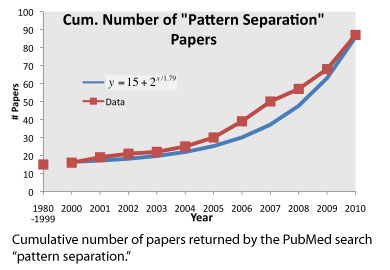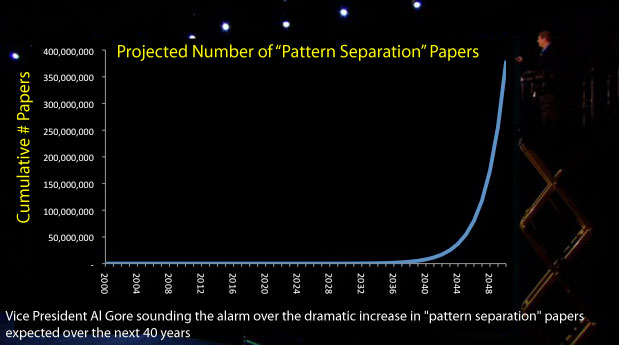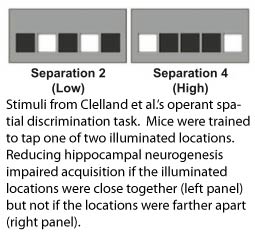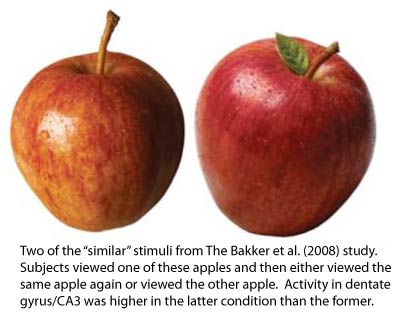 If you’ve been paying attention to the adult hippocampal neurogenesis literature at all, you noticed that “pattern separation” is gaining popularity as a research topic. A few quick searches on Pubmed confirm that a trend is indeed afoot. For the years prior to 1999, only 15 Pubmed-indexed papers answer to the keyphrase “pattern separation.” This number holds roughly steady through about 2003, and then it begins to take off. As of this moment (September 24, 2010 @ 3:27pm CST), we are up to 81 papers. According to my back-of-the-envelope calculations, we are in a period of exponential growth. Should this trend hold –and I see no signs of it abating– we can expect upwards of 370 million pattern separation papers by 2050. Can you imagine what a comprehensive exam will be like? Your child (grandchild?) will face a stack of journal articles almost 500 miles high! Al Gore, from atop his famous scissor lift, will inveigh against the massive deforestation wreaked by our prolific little research community. What’s that you say? We’ll all be using iPads? Fair enough.
If you’ve been paying attention to the adult hippocampal neurogenesis literature at all, you noticed that “pattern separation” is gaining popularity as a research topic. A few quick searches on Pubmed confirm that a trend is indeed afoot. For the years prior to 1999, only 15 Pubmed-indexed papers answer to the keyphrase “pattern separation.” This number holds roughly steady through about 2003, and then it begins to take off. As of this moment (September 24, 2010 @ 3:27pm CST), we are up to 81 papers. According to my back-of-the-envelope calculations, we are in a period of exponential growth. Should this trend hold –and I see no signs of it abating– we can expect upwards of 370 million pattern separation papers by 2050. Can you imagine what a comprehensive exam will be like? Your child (grandchild?) will face a stack of journal articles almost 500 miles high! Al Gore, from atop his famous scissor lift, will inveigh against the massive deforestation wreaked by our prolific little research community. What’s that you say? We’ll all be using iPads? Fair enough.

I’m kidding, of course, about the predictions. But I do think “pattern separation” is starting to interest a lot of people and that it would be worthwhile to step back and consider how we got here (and where we are).
In the past year or so there were two very interesting papers by the Bussey and Gage groups relating adult hippocampal neurogenesis to pattern separation. One paper (Clelland et al., 2009) is notable because, in my opinion, it is one of the strongest papers to date linking adult hippocampal neurogenesis to a psychological process. The paper rises above previous work because it uses two independent behavioral tasks to assess a single psychological construct. Compare this to the usual single-task approach—for instance, the work demonstrating that blocking adult hippocampal neurogenesis impairs contextual fear conditioning (… to pick an example at random). The fear conditioning finding, by itself, gives us relatively little insight into the underlying psychological mechanism: is it a failure to remember the shock context, a failure to associate a context with an aversive outcome, a failure to discriminate the shock contexts from other contexts? One way to generate more specific mechanistic information is to use multiple tasks that vary in their behavioral requirements but share a common psychological requirement. This is the approach used by Clelland et al., who demonstrated the blocking neurogenesis impairs the ability to discriminate nearby (but not far-apart) spatial locations.  The paper used two tasks that differed substantially in their behavioral requirements: One task was an operant location discrimination in mice; the other was a spatial version of delayed-non-match-to-place in rats. The fact that both tasks detected a similar effect of arresting neurogenesis constitutes pretty strong evidence that adult hippocampal neurogenesis plays a role in fine spatial discriminations. (The other paper showed that spatial discrimination performance is enhanced by exercise, which potently stimulates neuronal proliferation in the hippocampus.)
The paper used two tasks that differed substantially in their behavioral requirements: One task was an operant location discrimination in mice; the other was a spatial version of delayed-non-match-to-place in rats. The fact that both tasks detected a similar effect of arresting neurogenesis constitutes pretty strong evidence that adult hippocampal neurogenesis plays a role in fine spatial discriminations. (The other paper showed that spatial discrimination performance is enhanced by exercise, which potently stimulates neuronal proliferation in the hippocampus.)
So there you have it: the function of adult hippocampal neurogenesis is pattern separation. But how much does this really tell us about the psychology? If you think about it, almost any psychological process constitutes a form of pattern separation. Take a simple classical conditioning experiment: a tone is paired with food. To learn the association, the subject must isolate the tone from among the blooming, buzzing confusion of other sensory stimuli present during the trial. The pattern of sensory stimulation provided by the tone must be separated from the sound of the whirring exhaust fan, the odor of fresh bedding, the sight of the illuminated houselight, etc. This is pattern separation. Take another example: probabilistic category learning (e.g., the weather prediction task). The subject learns to predict an outcome using an assortment of multidimensional stimuli, with each stimulus providing only partial information about the outcome. With practice, the subject learns to separate the complex patterns of stimuli into different categories. This is pattern separation. Except the hippocampus (and, by inference, adult hippocampal neurogenesis) is not very important for either of these tasks.
The term “pattern separation,” as people are currently using it, comes from the computational literature, where it refers to an operation in which overlapping patterns of input stimulation are transformed into non- (or less-) overlapping patterns of output stimulation. Through pattern separation, stimuli that activate a common population of neurons are made to activate separate populations of neurons. According to several models (e.g., O’Reilly & McClelland, 1994), this operation occurs in the dentate gyrus.
So how does this computational pattern separation map onto behavior? Ray Kesner’s group has been investigating this question for a while, and they have shown that lesions of the dentate gyrus impair fine spatial discriminations but do not impair other types of discrimination, such as temporal order or reward magnitude discriminations. Work by the Leutgebs and Mosers confirms that the dentate granule cells are very sensitive to small spatial changes (read more about this here). But dentate gyrus pattern separation is not strictly spatial. A recent human imaging study (Bakker et al., 2008) showed that the dentate gyrus (and possibly CA3) are activated when people see objects that are very similar to –but not the same as– objects they’ve seen before.

More generally, we know that the dentate gyrus receives input from most or all sensory modalities, suggesting that the dentate gyrus does not operate solely on spatial information. So, while it seems clear that adult hippocampal neurogenesis has an important role in spatial pattern separation, some key questions remain. Is dentate gyrus involved in pattern separation across multiple perceptual modalities? If so, what defines dentate gyrus pattern separation relative to the other types of pattern separation in the brain? And does adult hippocampal neurogenesis contribute to all types of dentate pattern separation or to only a subset?
For answers, stay tuned to the next 369,999,999 papers.
How do you think about this method? Because the pattern separation tests need a long time to carry on, sometimes more than 3 months. However, it is really very interesting research focusing on the special iPad for mouse.
A good point. Was the impairment caused by the acute loss of new neurons or the cumulative effects of blocking neurogenesis for several months? What would happen if the mice were pretrained on the task and then neurogenesis was blocked? I don’t think the long training period makes their finding any less interesting. Still, it would be nice to know if/how it modulated their effect.
Just a quick commentary on pattern separation. One thing of note that is often ignored with pattern separation is the modality of it. Ray Kesner’s group (where I worked for quite a long time) has shown temporal pattern separation in CA1 of the hippocampus (PMID: 19733676) and affect pattern separation in the amygdala (PMID: 11991762 ). There has even been reports from Don Wilson’s lab concerning pattern separation in the perirhinal cortex for olfactory stimuli (PMID: 19686152).
At the moment, the vogue is in spatial pattern separation in rodent models and perceptual/object based pattern separation in human studies. It would be great to know over time what the role of different regions of the brain (not just the hippocampus) is in processing pattern separation-like processes across modalities.
Thanks Ryan. Yes, and –I think this is what you are implying– it would be interesting to know whether the dentate (or amygdala or perirhinal cortex) involvement in pattern separation applies to remote memories in addition to recent memories. Or is pattern separation subject to systems reconsolidation? (I like the Kesner work you mentioned.)
Pingback: #SfN13 Running boosts cognition by increasing aerobic capacity – Neurorexia